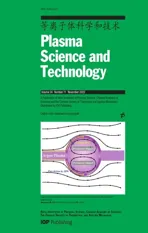Formation of honeycomb-Kagome hexagonal superlattice pattern with dark discharges in dielectric barrier discharge
2022-11-17YuyangPAN潘宇扬JianyuFENG冯建宇CaixiaLI李彩霞andLifangDONG董丽芳
Yuyang PAN(潘宇扬),Jianyu FENG(冯建宇),Caixia LI(李彩霞) and Lifang DONG(董丽芳)
1 College of Quality and Technical Supervision,Hebei University,Baoding 071002,People’s Republic of China
2 College of Physics Science and Technology,Hebei University,Baoding 071002,People’s Republic of China
Abstract A honeycomb-Kagome hexagonal superlattice pattern with dark discharges is observed in a dielectric barrier discharge system for the first time.The spatiotemporal structure of the honeycomb-Kagome hexagonal superlattice pattern with dark discharges is investigated by an intensified charge-coupled device and the photomultipliers show that it is an interleaving of three different sub-lattices,which are bright-spot,invisible honeycomb lattice,and Kagome lattice with invisible frameworks and dim-spots,respectively.The invisible honeycomb lattices and Kagome lattices are actually composed of dark discharges.By using the optical emission spectra method,it is found that the plasma parameters of the three different sub-lattices are different.The influence of the dark discharges on pattern formation is discussed.The results may have significance for the investigation of the dark discharges and will accelerate the development of self-organized pattern dynamics.
Keywords:dielectric barrier discharge,pattern,Kagome lattice,dark discharge,optical emission spectra,spatiotemporal structure
1.Introduction
The Kagome lattice is a two-dimensional(2D)network of corner-sharing triangles.Its essential characteristic is that there are four neighboring points for each lattice point[1-6].It was observed in the process of exploring phase transitions by Kôdi Husimi and Itiro Syôzi in 1951.Since then,the Kagome lattice has become an important component of lattice structures and has been widely studied in many fields,such as magnetic materials,spin liquids,non-trivial topology,photonic crystals,semiconductors,superconductors,mechanisms,lasers and so on[7-15].Recently,the Kagome lattice has been presented in and is attracting attention in dielectric barrier discharge(DBD)systems.Dong Lifanget alreported a Kagome lattice with discrete spots clearly visible to the naked eye in a complex hexagonal superlattice pattern[16].Sun Haoyanget alisolated a Kagome lattice based on the triangular pattern which is invisible to the naked eye[17].In this article,a new Kagome lattice with invisible frameworks and dim-spots in the honeycomb-Kagome hexagonal superlattice pattern with dark discharges is exhibited in a DBD system.It is worth pointing out that the complete Kagome lattice is indistinguishable to the naked eye or an ordinary camera and can only be detected with the help of an intensified charge-coupled device(ICCD).The Kagome lattice is a spatial structure in condensed matter physics.However,the Kagome lattice is a spatial structure with time variation in a DBD system.Therefore,research of the Kagome lattice in a DBD system will further expand the application of the Kagome lattice,especially for plasma photonic crystals(PPCs).In addition,the invisible honeycomb lattice is also presented in this work.It is well known that the honeycomb structure,as a basic structure,has been widely reported in the pattern field[16,18-21].However,the invisible honeycomb lattice has not before been presented in a DBD system.What is so amazing in this work is that there are two sets of different invisible sub-lattices,which are composed of dark discharges in a complex hexagonal superlattice pattern.Therefore,the results provide a novel method to generate the Kagome lattice and enrich the types of the discharges and patterns.
In recent years,the DBD system,known for its incredible accessibility and utility for experimental devices,has been verified as an amazing and preferred system for the investigation of pattern dynamics,because it exhibits an exceptionally great variety and abundance of self-organized patterns[16-23].Due to the luminous intensity,there not only exist visible discharge filaments to the naked eye or an ordinary camera,which is called normal discharge,but also discharge filaments exist that are invisible to the naked eye or an ordinary camera,which called dark discharge in the DBD system.Dark discharge is difficult to detect in experiments,due to its small particle density and low emission intensity.In 2013,Fan Weiliet alpresented dark discharge through a twodimensional particle-in-cell simulation with Monte Carlo collisions included[24].However,there are few relevant reports of experimental studies at present[17].Here,two different sub-lattices which are composed of dark discharges are obtained by ICCD in the honeycomb-Kagome hexagonal superlattice pattern with dark discharges.Meanwhile,the results show that the dark discharges have an important influence on the formation of the honeycomb-Kagome hexagonal superlattice pattern with dark discharges.
In this paper,we report the complex honeycomb-Kagome hexagonal superlattice pattern with dark discharges in a DBD system for the first time.The spatiotemporal structures and plasma parameters of the honeycomb-Kagome hexagonal superlattice pattern with dark discharges are investigated by ICCD,photomultipliers(PMTs)and spectrograph,respectively.Furthermore,the effect of the dark discharges on the formation of the honeycomb-Kagome hexagonal superlattice pattern with dark discharges is analyzed.The results may not only speed up the realization of the dark discharge in gas discharge system,but also solve another new mystery for DBD dynamics.
2.Experimental setup
The schematic diagram of the experimental setup is described in figure 1.The core section of the experimental setup is two water electrodes processed from the cylindrical containers.The glass plates are used to seal the end faces of the cylindrical containers for the purpose of filling with water.A sinusoidal AC power supply with a driven frequency of 53 kHz is introduced to the water electrodes through the copper ring which is submerged in the water.The discharge space is achieved by installing a hollow circle with a diameter of 50 mm on a glass plate with a thickness of 5 mm between the water electrodes.The whole core section is installed in a chamber whose gas pressure and content can be adjusted.A high-voltage probe(Tektronix P6015A 1000×)and a current probe(Tektronix TCP0030A)is added to the circuit to measure the voltage and current signals,respectively.The signals are displayed and recorded by a digital phosphor oscilloscope(Tektronix TDS 3054B).Discharge photographs are recorded with a digital camera(Canon Power Shot G16).The instantaneous photographs in successive discharge current pluses are obtained by an intensified chargecoupled device(HSFC-Pro.3 channels).The optical signals of the discharges are collected by photomultipliers(PMT,RCA 7265).The optical emission spectra are acquired by a spectrograph(Acton Advanced SP 2750 A,CCD:1340×400 pixels).
3.Results and discussions
Figure 2 describes the evolution sequence of the honeycomb-Kagome hexagonal superlattice pattern with dark discharges with increasing voltage.First,when the gas has just been ignited,a few filaments with a random motion are generated in the discharge space in figure 2(a).When the voltage rises to 5.4 kV,numerous filaments are ignited and interact with each other,resulting in the formation of the honeycomb superlattice pattern,as shown in figure 2(b).With the voltage increasing further,the honeycomb superlattice pattern disappears,and the honeycomb-Kagome hexagonal superlattice pattern with dark discharges emerges at 7.7 kV,as shown in figure 2(c).Eventually,the entire space is occupied by the chaos state,when the voltage reaches as high as 10.6 kV,as shown in figure 2(d).From figure 2(c),it is obvious that the honeycomb-Kagome hexagonal superlattice pattern with dark discharges contains two different kinds of discharge filaments.There is a very big difference in the brightness of the two different kinds of discharge filaments.The phenomenon has attracted a great deal of attention and interest in previous reports.In 2015,Liu Yinget alpresented a novel superlattice pattern with surface discharges in a DBD system[25].The bright-spot and the dim-spot situated at the geometric center of the triangle which is formed by three adjacent bright-spots are the main elements that form the pattern.The reason for the formation of the dim-spot is that the surface discharges induced by the bright-spots extend to the geometric center of the triangle.Li Caixiaet alalso exhibited a hexagonal superlattice pattern with bright and dim-spots,and described a new discharge behavior which they called selective discharge[26].The reports related to the bright-dim spots patterns seem to have consistently given surprising results[25-27].Here,the honeycomb-Kagome hexagonal superlattice pattern with dark discharges consists of bright-spots and dim-spots as well,as shown is figure 2(c).However,the dim-spot is located at the center of the two bright-spots,instead of the three bright-spots as previously reported.In addition,the brightness of the dim-spots is much lower than those in previous reports and the dim-spots are even harder to observe with the naked eye.To be able to observe the existence of the dim-spots more easily,a black and white image of one cell of the honeycomb-Kagome hexagonal superlattice pattern with dark discharges is shown in the upper right corner of figure 2(c).Considering the above differences,it implies that the formation mechanism of the dim-spots may be quite different from the previous patterns.

Figure 1.Schematic diagram of the experimental setup.
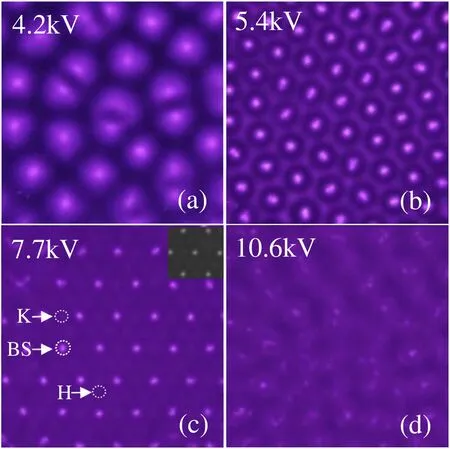
Figure 2.Evolution of patterns with the increase of applied voltage.(a)Filaments with disordered motion,U=4.2 kV,(b)honeycomb superlattice pattern,U=5.4 kV,(c)honeycomb-Kagome hexagonal superlattice pattern with dark discharges,U=7.7 kV and(d)chaos state,U=10.6 kV.Experimental parameters:discharge gap d=5 mm,driven frequency f=53 kHz,chamber pressure p=6 kPa,exposure time t=25 ms.
It is well known that self-organized patterns are very sensitive to experiment parameters.Figure 3 illustrates the phase diagram of the honeycomb-Kagome hexagonal superlattice pattern with dark discharges as a function of gas pressurepand the concentration of argon χ.The pattern is observed in the ranges of pressure from 6 to 8.5 kPa and the concentration of argon from 0% to 30% approximately.It is worth pointing out that the pattern is the most stable and exists for a longer time when the concentration of argon is 0%,i.e.air.
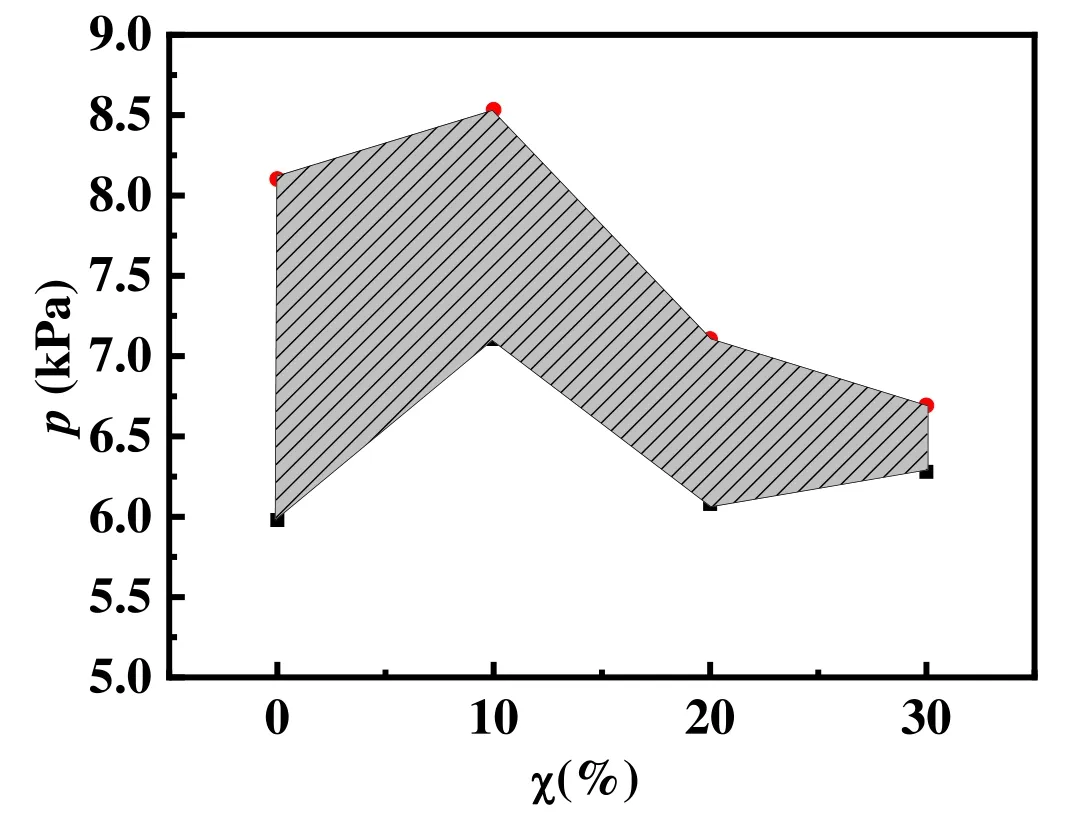
Figure 3.Phase diagram of the honeycomb-Kagome hexagonal superlattice pattern with dark discharges as a function of gas pressure p and the concentration of argon χ.
Figure 4(a)depicts the voltage and current signals of the honeycomb-Kagome hexagonal superlattice pattern with dark discharges.It can be clearly seen that there are three distinct pulses in the current signal.In general,the number of the pattern’s sub-lattices has a strong correlation with the number of current pulses in the DBD system.From figure 2(c),it can be speculated that the honeycomb-Kagome hexagonal superlattice pattern with dark discharges should be composed of two different sub-lattices at most,i.e.bright-spots and dimspots.Another possibility is that the bright-spots or dim-spots lattice is composed of two sets of identical sub-lattices but corresponds to different current pulses phases,just like the square pattern[28].Namely,the honeycomb-Kagome hexagonal superlattice pattern with dark discharges consists of bright-spots,bright-spots and dim-spots or bright-spots,dimspots and dim-spots.Otherwise,the number of current pulses cannot correspond exactly with the number of the sub-lattices of the pattern.In other words,there seems to be some doubt regarding the number of current pulses and the number of sub-lattices of the honeycomb-Kagome hexagonal superlattice pattern with dark discharges.This doubt has aroused strong interest in exploring the spatiotemporal structure of the honeycomb-Kagome hexagonal superlattice pattern with dark discharges.For the purpose of investigating the spatiotemporal structure of the honeycomb-Kagome hexagonal superlattice pattern with dark discharges,time-resolved photographs are acquired with the help of the ICCD.Three current pulses phases are tagged byΔt1,Δt2,andΔt3in figure 4(a).Time-resolved photographs integrated over 100 voltage cycles are saved and are presented in figures 4(b)-(d),respectively.Figure 4(e)shows the superposition of figures 4(b)-(d).The results reveal that the honeycomb-Kagome hexagonal superlattice pattern with dark discharges consisted of three different sub-lattices.They are bright-spots,invisible honeycomb lattices,and Kagome lattices with invisible frameworks and dim-spots,respectively.Therefore,the discharge sequence is also confirmed,following a sequence of bright-spots,invisible honeycomb lattices,and Kagome lattices.It is worth pointing out that the invisible honeycomb lattices and the invisible frameworks of Kagome lattices corresponding toΔt2andΔt3are invisible in figure 2(c).The discharges that cannot be seen in figure 2(c)are defined as the dark discharges.In fact,the number of current pulses is still consistent with the number of sub-lattices in the pattern.The reason for the misunderstanding is that some sub-lattices cannot be directly observed by the naked eye or an ordinary camera.The results further show that the ICCD has huge advantages for investigating the pattern dynamics.
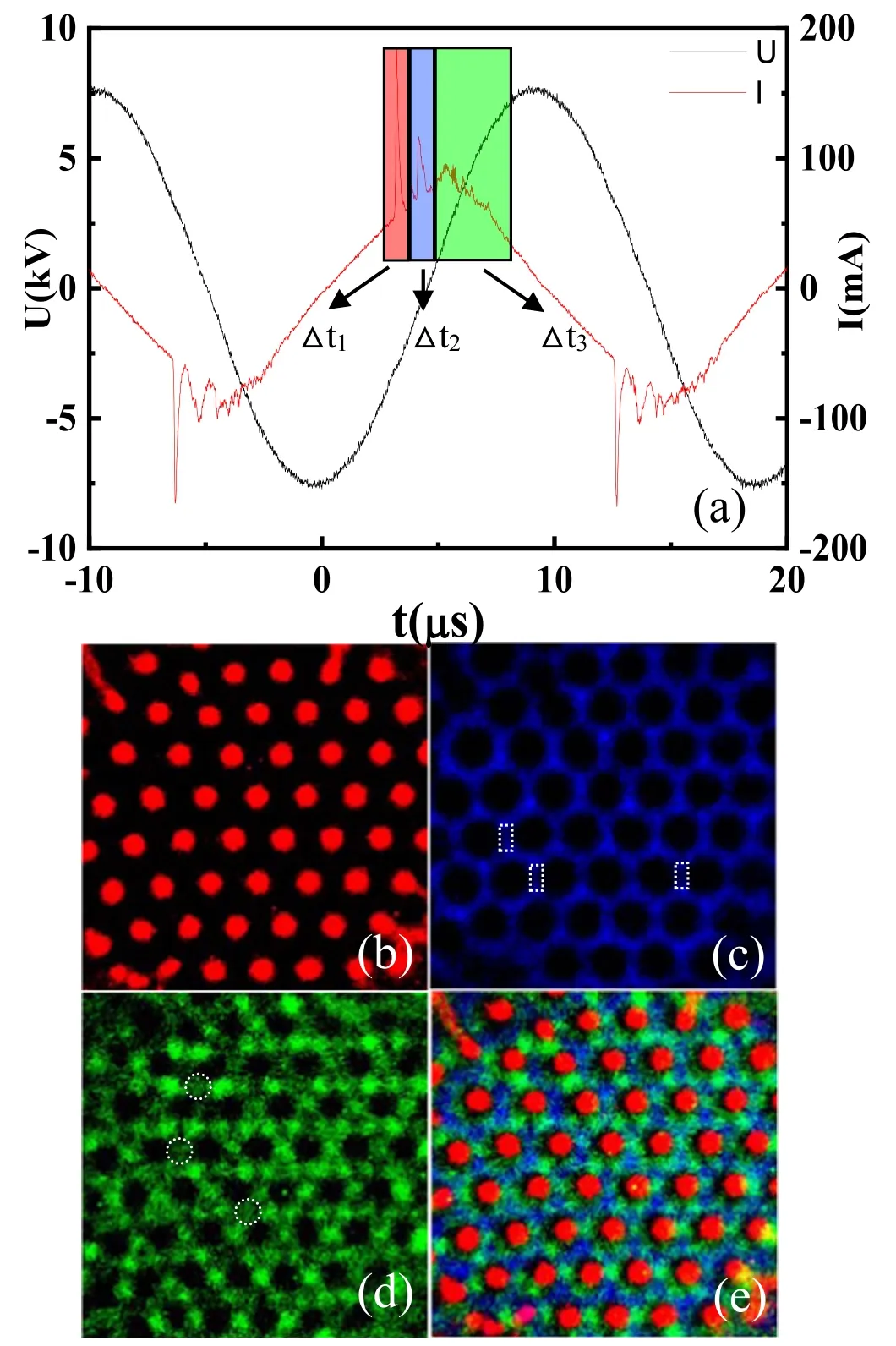
Figure 4.(a)Signal of the voltage and the current.(b)-(d)The exposed photographs integrated over 100 voltage cycles correspond to the current pulse phases tagged byΔt1,Δt2 andΔt3 in figure 4(a),respectively.(e)Superposition of(b)-(d).
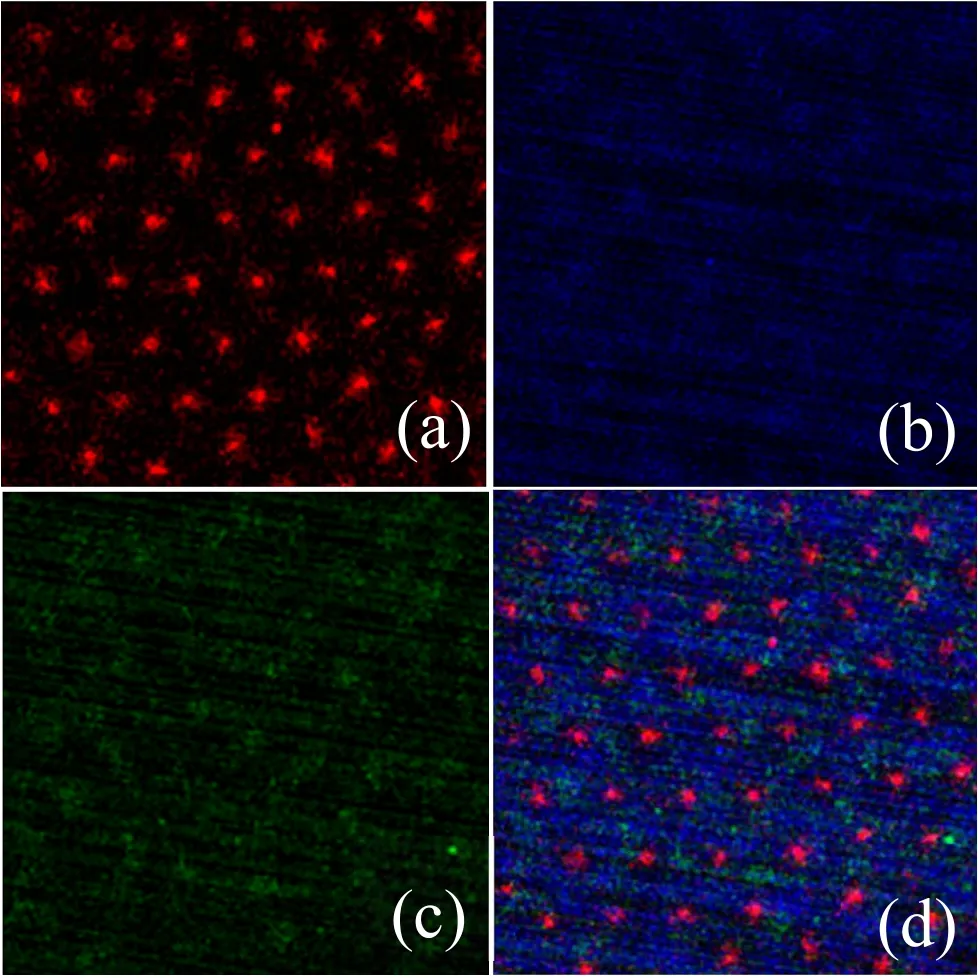
Figure 5.Instantaneous photographs of the pattern in one voltage cycle.(a)-(c)The exposed photographs correspond to the current pulse phases tagged byΔt1,Δt2 andΔt3 in figure 4(a),respectively.(d)Superposition of(a)-(c).
To obtain the distinct structure of the pattern,integrated photographs over multi-cycles are usually utilized first.Equally,the instantaneous photographs obtained in one voltage cycle are indispensable for getting to know the essential attributes of the patterns[22,26].Hence,the photographs in one voltage cycle whose exposure time corresponded toΔt1,Δt2,andΔt3in figure 4(a)are captured and presented in figure 5.The results illustrate that the sublattices of bright-spots are observed clearly in figure 5(a).Whereas,each photograph exhibits some random individual filaments instead of the complete structure of the invisible honeycomb lattices and Kagome lattices,as shown in figures 5(b)and(c).Figure 5(d)is the superposition of figures 5(a)-(c).The results indicate that the random individual filaments in figures 5(b)and(c)are distributed around the bright-spots in figure 5(a).Comparing figure 4 with figure 5,it is found that both the invisible honeycomb lattices and Kagome lattices are actually composed of individual filaments.That is to say,the dark discharges are still individual filaments in essence.
To further determine the intrinsic properties of the discharge filaments that make up the invisible honeycomb lattices and Kagome lattices,the temporal correlations of the optical signals between different discharge filaments are simultaneously measured by two PMTs with higher sensitivity and are shown in figure 6.The bright-spots,invisible honeycomb lattices and Kagome lattices are denoted by BS,H and K respectively,as shown in figure 2(c).Figures 6(a)and(b)present the temporal correlations between BS and H,and BS and K.It can be found that the bright-spot ignites in the first pulse phase of the current and in every half voltage cycle.Meanwhile,the invisible honeycomb lattice and Kagome lattice are generated in the second and third pulse phase of the current.The difference with the bright-spot is that the invisible honeycomb lattice and Kagome lattice do not ignite in every half voltage cycle,resulting in random properties.It can be found that the invisible honeycomb lattices and Kagome lattices are actually composed of discharge filaments.The results of the temporal correlation are consistent with the results obtained with ICCD.It is worth pointing out that the optical signal intensity of the invisible honeycomb lattice and Kagome lattice is significantly different from those of the bright-spots at the same magnification.The optical signal intensities of the invisible honeycomb lattice and Kagome lattice are about 5-10 times lower than those of the bright-spots.It is further illustrated that the discharge filaments that make up the invisible honeycomb lattices and Kagome lattices are different from those of the bright-spots.

Figure 6.Time correlation measurement of the honeycomb-Kagome hexagonal superlattice pattern with dark discharges.BS stands for a bright-spot,H stands for the invisible honeycomb lattice and K stands for the Kagome lattice.(a)Time correlation measurement of BS and H.(b)Time correlation measurement of BS and K.
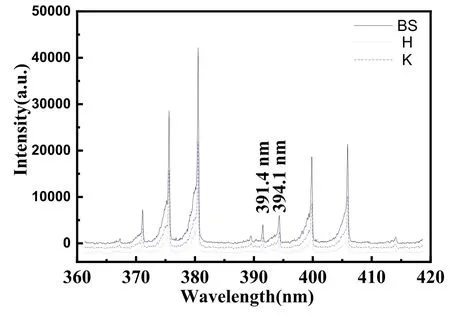
Figure 7.Optical emission spectra in the range of 360-420 nm.

Figure 8.The molecular vibration temperatures of the different sublattices.

Figure 9.The electron average energies of the different sub-lattices.
In this experiment,thepdvalue(the product of the gas pressurepand width of discharge gapd)is about 22.5 Torr·cm.Thepdvalue is lower than those of previously reported patterns with sub-lattices that are composed of discharge filaments in dozens of Torr cm to hundreds of Torr cm[16-19].Under thispdvalue,there not only exist discharge filaments that make up the previously reported pattern,but also dark discharges exist that are invisible to the naked eye or an ordinary camera.The optical signal intensity of the dark discharge is about 5-10 times lower than that of the discharge filament that makes up previously reported patterns.The results are very similar to the results which present the dark discharge through a two-dimensional particle-in-cell simulation with Monte Carlo collisions included by Fan Weiliet al[24].In a word,the three different sub-lattices are made up of two different kinds of individual filaments.The bright-spots are composed of individual filaments with a larger diameter and higher brightness,while the invisible honeycomb lattices and Kagome lattices are composed of individual filaments with a smaller diameter and lower brightness than those of the bright-spots.
As we described before in figure 2(c),it can be found that the brightness of the bright-spot(BS),invisible honeycomb lattice(H)and Kagome lattice(K)are different,implying that they should be in different plasma states.For the purpose of further clarifying the distinction among them,the optical emission spectra of the N2second positive band(C3Πu→B3Πg)are acquired and presented in figure 7.The six spectral bands ofΔv=-2(0-2,1-3,2-4)and Δv=-3(0-3,1-4,2-5)in the N2second positive band(C3Πu→B3Πg)are selected to investigate the molecule vibration temperature[29-31].The electron average energy is also investigated according to the band head intensities ratio oftransition at 391.4 nm and N2(C,2-B,5)transition at 394.1 nm[22,31].The results of the plasma parameters of different sub-lattices,including the molecule vibration temperatures and electron average energies,are presented in figures 8 and 9.The results indicate that the descending sequence of the molecule vibration temperature follows H-K-BS,while the descending sequence of the electron average energy follows BS-K-H.It can be clearly seen that H possesses the largest molecule vibration temperature but the lowest electron average energy.That is to say,the dark discharge has the largest molecule vibration temperature and the lowest electron average energy.From figure 7,it can be seen that the relative band head intensity ofN2+(B,0-X,0)transition at 391.4 nm of H is the lowest compared with other sub-lattices,indicating that the dark discharge has the lowest density of ions.The above results show that the plasma parameters of the three sub-lattices are very different.The dark discharge has the largest molecule vibration temperature,lowest electron average energy and ion density.The plasma parameters calculated by the optical emission spectra may in future offer simulation parameters for the theoretical study of the dark discharge in pattern dynamics.
Based on the above results,we have obtained a deep understanding of the spatiotemporal structures and plasma parameters of the honeycomb-Kagome hexagonal superlattice pattern with dark discharges,thus discussion of the pattern formation is important.As is well known,the wall charge plays a pivotal effect in the process of the self-organized pattern formation in a DBD system.The wall charge is created by the discharge filament and then deposits on the surface of the dielectric layer at the corresponding discharge location.The wall charges which are deposited on the surface of the dielectric layer build an internal electric field.When the effective electric field(vector sum of the internal electric field and the applied electric field)exceeds the threshold of the reaction gas,the gas is broken down.As a result,the discharge filaments are created between the two electrodes.As for the formation mechanism of the honeycomb-Kagome hexagonal superlattice pattern with dark discharges,the discharges are generated at the location of the bright-spots first.It is proved that the effective electric field at the locations of the bright-spots is the largest compared to other locations in the entire discharge space.There is no doubt that the locations corresponding to the bright-spots deposit wall charges when the discharges are extinguished.The distribution of the internal electric field generated by the wall charges then further affects the locations of new discharges.More specifically,the wall charges generate a prohibitive effect on the surrounding locations of wall charges.New discharges are more likely to be ignited farther from the previous discharge locations,by reason of having the weakest prohibitive effect generated by previous wall charges.Therefore,it is clear that new discharges are prone to occur at the locations of the invisible honeycomb lattices,because the prohibitive effect at these locations generated by the wall charges of bright-spots is more feeble than at other locations.Similarly,the wall charges generated by invisible honeycomb lattices deposit at the corresponding locations as well.As for the formation of the Kagome lattices,the discharge locations are influenced by the wall charges generated by the bright-spots and invisible honeycomb lattices.In general,the estimated number of transferred charges reflect the wall charges,which is proportional to the number of wall charges,as wall charges cannot be accurately measured at present.The electric quantities of the filaments of the bright-spots(Δt1)and invisible honeycomb lattices(Δt2)can be calculated byQI td,∫=respectively[18,25].The transferred charges of the brightspots and invisible honeycomb lattices are aboutQΔt1=49 ×10-9CandQΔt2=48 ×10-9C,respectively.It can be found that the total number of transferred charges is substantially equal in half of the voltage cycle.However,the invisible honeycomb lattices are composed of numerous individual filaments with smaller diameter than the brightspots,even though they look diffuse,as mentioned earlier.That is,the number of transferred charges for a single discharge filament corresponding to the invisible honeycomb lattices is far smaller than that for a single discharge filament of the bright-spot.Considering that the optical signal intensity of the invisible honeycomb lattice is about 5-10 times lower than that of the bright-spot,it can be speculated that the number of transferred charges of the invisible honeycomb lattices is about 5-10 times lower than that of the bright-spots.In other words,the number of wall charges(charge density)of the invisible honeycomb lattices is about 5-10 times lower than that of the bright-spots.This further illustrates that the discharge filaments that make up the invisible honeycomb lattices are different from the discharge filaments that make up the bright-spots.The results are very similar to the results which present the dark discharge through a two-dimensional particle-in-cell simulation with Monte Carlo collisions included by Fan Weiliet al.It claims that the charge density of the dark discharge is lower by an order of magnitude compared with other filaments.Besides,the optical emission spectra show that the invisible honeycomb lattice has the lowest electron average energy and ion density.The discharge filaments that make up the bright-spots possess a larger diameter,brightness,electron average energy and ions density than the invisible honeycomb lattices.Therefore,it can be clearly seen that the wall charges deposited at the locations of the bright-spots are greater than those of the invisible honeycomb lattices.As a result,the prohibitive influence on the new discharges produced by the bright-spots is stronger than that of the invisible honeycomb lattices.The locations of new discharges keep away from the locations of the bright-spots and invisible honeycomb lattices.In comparison,these locations are closer to the locations of the invisible honeycomb lattices.The locations of the Kagome lattices satisfy this requirement.However,it does not seem to explain the formation of the dim-spots in the Kagome lattices.In fact,the results discussed above are reasonable for the explanation of the formation of invisible frameworks in the Kagome lattices.As for the dim-spots in the Kagome lattices,it can be clearly seen that there are some absent links in some invisible honeycomb lattices,as marked by the dashed rectangles shown in figure 4(c).That is to say,those locations do not accumulate or accumulate fewer wall charges when the discharges of the invisible honeycomb lattices are extinguished.Therefore,the probability of new discharges at those locations is greater than at the locations of invisible frameworks in Kagome lattices.That is the reason why the dim-spots are generated in these locations,which can also be confirmed in figure 4(d).From figure 4(d),it can be found that there are no dim-spots where dim-spots should appear,but a diffuse structure like the invisible framework is presented in the Kagome lattices,as marked by the dotted circles.In brief,the spatiotemporal structure of the honeycomb-Kagome hexagonal superlattice pattern with dark discharges is closely connected with the distribution of the effective electric field.The distribution of the internal electric field created by wall charges affects the preferred locations for the following ignition.Due to the appearance of the invisible honeycomb lattices with the lowest ion density and electron average energy,the formation of the Kagome lattices becomes possible.In other words,the dark discharge has an important effect on the formation of the honeycomb-Kagome hexagonal superlattice pattern with dark discharges.
4.Conclusion
The honeycomb-Kagome hexagonal superlattice pattern with dark discharges is studied in a DBD system for the first time.The spatiotemporal structures and plasma parameters of the honeycomb-Kagome hexagonal superlattice pattern with dark discharges are investigated by ICCD,PMTs and spectrograph,respectively.The results indicate that the honeycomb-Kagome hexagonal superlattice pattern with dark discharges is composed of three different sub-lattices,which are brightspot,invisible honeycomb lattice,and Kagome lattice which consists of invisible frameworks and dim-spots,respectively.Instantaneous photographs in one voltage cycle reveal that the invisible honeycomb lattices and Kagome lattices are actually made up of individual filaments.The dark discharges are still individual filaments in essence.Given the results of the optical emission spectra,it can be concluded that the plasma parameters of the three different sub-lattices are different.The dark discharge has the largest molecule vibration temperature but the lowest electron average energy and ion density.Due to the appearance of the invisible honeycomb lattices,the Kagome lattices are able to present in the honeycomb-Kagome hexagonal superlattice pattern with dark discharges.The absences of links in some invisible honeycomb lattices further result in a higher probability of new discharges at the locations of the dim-spots compared to at other locations in Kagome lattices.Dim-spots are generated instead of the invisible frameworks at those locations.The dark discharge has an important influence on the formation of the honeycomb-Kagome hexagonal superlattice pattern with dark discharges.
Acknowledgments
This work is supported by National Natural Science Foundation of China(No.12075075)and Natural Science Foundation of Hebei Province,China(Nos.2020201016 and A2018201154).
猜你喜欢
杂志排行
Plasma Science and Technology的其它文章
- An equivalent model of discharge instability in the discharge chamber of Kaufman ion thruster
- Discharge and jet characteristics of gliding arc plasma igniter driven by pressure difference
- Investigation of stimulated growth effect using pulsed cold atmospheric plasma treatment on Ganoderma lucidum
- Comparative study of pulsed breakdown processes and mechanisms in self-triggered four-electrode pre-ionized switches
- Nanosecond laser preheating effect on ablation morphology and plasma emission in collinear dual-pulse laser-induced breakdown spectroscopy
- Interaction of an unwetted liquid Li-based capillary porous system with high-density plasma
